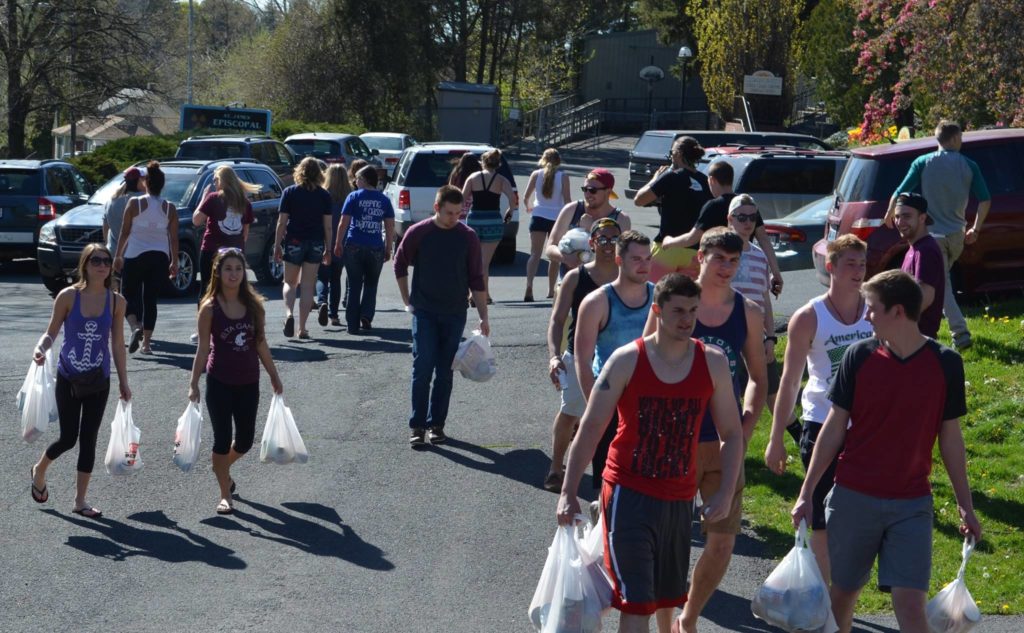How Can We Help?

Community Engagement
Engaging the community in gardening, cooking and nutrition education has been about continuing the dialogue with key community stakeholders and members from the Palouse Tables Project. Maintaining and engaging those relationships as well as cultivating new relationships are all key components of community engagement.
Cultivating community engagement was a key component of the Community Educator Program. Community engagement took the form of tabling, attending board meetings, evaluations, word-of-mouth advertising and maintaining a presence online through Facebook and an e-newsletter. It was important to make connections with groups and individuals from the community at the beginning of the project to gauge how many people would be interested and able to facilitate leading cooking and gardening demonstrations. This proved to be a main difficulty in maintaining volunteers who were initially interested in leading demonstrations or who attended orientations for demo leaders and then became hard to reach. The second year VISTA started the year with a list of contacts from community members that had expressed interest in community education for the Community Food group. The people on the list were contacted and the ones who responded and expressed an interest in participating came to a Community Educator Orientation. This orientation was tested as a pilot and then refined as the second year VISTA held a total of five Community Educator Orientations throughout the first eight months of their service term. The numbers of people recruited and those who wanted to participate dwindled as the year went on, the majority of the people contacted from the orientations did not respond to the follow-up email or phone call. Community member participation has a lot to do with their personal lives and what time they are able to spend outside of work and family to dedicate to volunteering in the Community Educator program. Most of the community members who did come and perform a demo only wanted to once. It may take another year length of time to gather a list of people from the community who would be interested in participating in a program like this as the response rate from a list starting with around 30 people had only 10 who responded and desired to volunteer in the program.
For the volunteers who did schedule a demo and successfully led a demo, the second year VISTA member was able to continue to cultivate a working relationship with that volunteer. Sometimes the volunteer would want to return to do more work with the project and sometimes they weren’t able to, it was important to maintain an open dialogue and communication about the project while the VISTA member was with the volunteer in person. This best serves the volunteer as they have the attention and support that they need to successfully participate in this project and it also encourages feedback, be it positive or negative, between the VISTA member and the participating volunteer. It became important to focus energy on the volunteers who did express an interest in coming back to lead more demos so that they might be encouraged to continue participating. It became apparent throughout the project that the VISTA member needed to focus their energy on volunteer collaboration and program development simultaneously.
Utilizing different avenues of community engagement throughout the development of the Community Meal program proved successful and fruitful with each new Community Meal. The Community Meal program was thought of by the Pullman 2040 Food Security Initiative in order to come up with best practices to organize meals for the community. Pullman 2040 found that the community lacked enough free hot meals offered consistently throughout the week for community members who are food insecure. The Pullman 2040 Food Security Initiative in partnership with the Community Food group at the CAC started planning to hold free community meals once per season throughout the year of 2019. The CAC provided funding for the meals and the Pullman 2040 group provided planning support. The planning for these Community Meals has been documented so that the relationships created and resources utilized to make the meals possible can be used again for future meals by the Pullman 2040 Food Security Initiative.
Community engagement facilitated by the Center for Civic Engagement (CCE) has helped to link WSU students with volunteer projects in the Community Food department. The CCE has helped facilitate the use of the GivePulse volunteer platform. This platform provides the ability for students to find volunteer and service learning opportunities in the area, track their service hours, receive verification of time worked, and build a resume of their volunteer and service learning experiences. The platform allows organizations to communicate with volunteers, collect data, hours reviews, ratings, and feedback for their organization’s use and reporting. Another important tool of the GivePulse platform is that it allows an organization to coordinate with multiple stakeholders to track and share impacts from volunteers. The Community Food department at the CAC has just started to pay for membership, use the features and implement this platform from their previous volunteer program as of April 2019. View the CAC GivePulse page here .
Lastly, the Community Food department uses an e-newsletter through MailChimp and sends out these newsletters every Monday. The newsletter lists volunteer opportunities for the week in the Community Food department as well as other departments at the CAC, though volunteer positions are created predominantly for the Community Food department. Volunteers will respond to this newsletter with the shift they would like and the Volunteer Coordinator will schedule their request into department’s Outlook calendar for the coming week. This has worked well in scheduling volunteers to assist with the Food Bank and the Community Gardens.


